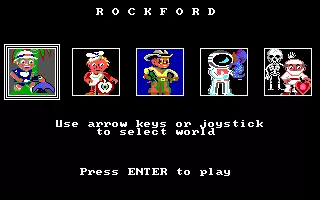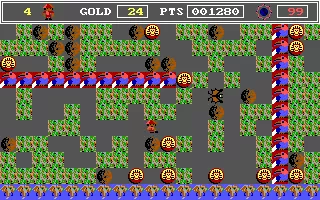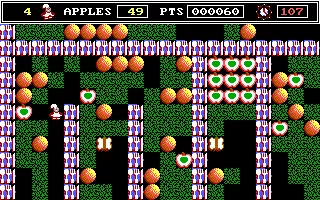Rockford: The Arcade Game
Description
This is a rocks'n'diamonds style game. Play in six different worlds (as a explorer, cook, doctor, etc.) of increasing difficulty, and grab the coins/apples/hearts while avoiding the boulders. And there are enemies to make your life (even more) difficult.
Groups +
Screenshots
Credits (Arcade version)
6 People
| Programmer | |
| Game Logic | |
| Graphics Engine | |
| Sound Engine | |
| Coin Drop Logic | |
| Arcade Machine Configuration and Statistics Code | |
| Levels | |
| Music | |
| Graphics and Attract Mode |
Reviews
Critics
Average score: 66% (based on 8 ratings)
Players
Average score: 3.1 out of 5 (based on 27 ratings with 1 reviews)
"Is there ANYTHING intelligent about this game?"
The Good
The graphics are quite modest, but they don't look bad anyway. Much better than in the most primitive variants of the Boulder Dash idea. However, what I like best is the game's division into five world with different items to collect, different enemies and generally different graphics. Every level ends with a short animated sequence which appears on top of the area - there are three variants for each world: after completing a level, after getting killed or after running out of time. These animations are often funny - for example the surgeon being chased by a giant syringe.
The game is generally very playable and replayable. It can get annoying, but the whole - very simple - idea of the game is nice enough to draw the player in.
The sentence used as a title was said years ago by my mum, with that, typical for many adults, disdain for games. But, contrary to the phrase's implication ("It's just a SILLY game!"), the game actually often requires some thinking. OK, it's no IQ test game, but it's also no dumb diamond chase - you often have to observe and act at the right moment, you have to get an idea how to make the fire go in the right direction (Body level 2), where to go first in order not to get stuck (Hunter level 2)...
Some ideas are used just once or twice. For example in the above mentioned Hunter level 2 the walls close horizontally, even though they look just like other walls in the same stage. Cook level 4 features a type of wall used only there, the one with grapes - boulders or collectable apples can fall through it (and hit a baddie trapped on a lower level - or, perhaps, hit the player character...). Space level 3 is the only one to feature the Amoeba - enemies will be killed and leave collectable suns behind, but you have to hurry to get enough suns because later the Amoeba turns into boulders. These details introduce yet more sense of surprise than just the ordinary "I've managed to get to a new level!". Several levels also have another interesting element: "snakes" which move and turn boulders either into collectables or into baddies. Cook level 1 even has both types!
The game also has another nice little feature: background color can be changed. I rather got used to the game's default colors, but anyway you can play with it if you like.
The Bad
The game is fairly short - only 4 levels per stage. While it doesn't mean that the game is easy - some levels are quite tough - the challenge can be over too soon.
Dividing the gameplay into several stages with different appearances was such a good idea that I think more of them could have been made. 20 levels altogether is quite little, so the game could have been yet better if it featured yet more stages.
Nothing nice to say about the sound - no melodies, and the sound effects are simple and rather annoying.
The Bottom Line
The difficulty level can vary quite much - for example the Hunter stage is very easy, completing level 2 of Space stage can be demanding. After completing a stage you go back to the menu and can choose another stage, but it's not so easy to complete the whole game in one go.
If you play this game, pay some attention to the menu or just remember: it has slightly untypical keys. "Escape" acts as the pause button, but to quit the game, you have to use "Q".
DOS · by Nowhere Girl (8782) · 2013
Trivia
Development
"Rockford" is a very rare example of the game that existed in the arcades as a conversion of home computer game. Usually it happened in the opposite direction - arcades were the source of conversion for home computers. Popularity of 8-bit "Boulder Dash" made a demand for it and "Rockford" debuted on Arcadia Systems. Sadly, the game was stripped of the original's simple and charming graphics and was less intuitive than the "Boulder Dash" games that inspired it. Mostly because you had to figure out what each element represented in each environment you were placed in (such as the Old West or outer space). The game also felt clunky compared with the streamlined and fluid original.
"Rockford" was later on converted to home systems such as Amiga and Atari ST, resulting in a conversion of an arcade game that itself was largely a conversion of a home computer game. The Arcade version ran on Amiga hardware, but not the Amiga OS. The port for the Amiga computer had to be done from scratch.
Awards
- ACE
- October 1988 (issue #13) - Included in the Top-100 list of 1987/1988 (editorial staff selection)
Analytics
Identifiers +
Contribute
Are you familiar with this game? Help document and preserve this entry in video game history! If your contribution is approved, you will earn points and be credited as a contributor.
Contributors to this Entry
Game added by rey_.
Atari 8-bit added by Rebound Boy. Atari ST, Commodore 64, Amiga, Amstrad CPC, ZX Spectrum added by Kabushi. Arcade added by vedder.
Additional contributors: vedder, mailmanppa, S Olafsson, Jo ST.
Game added May 8, 2001. Last modified January 17, 2025.

















